From now on I am going to adopt a more formalised diary approach so the 1st May is a blustery and showery day with some of the showers being rather heavy. A walk in the Park does not really produce much wildlife although it is nice to spot a Blackbird on the path with its beak full of green caterpillars. A good sign there is a nest with young nearby.
2nd May is a better day with sunshine but a cold wind. Still the insects are out and about in the garden with Myathorpa florea fighting for their sunlit spots and the gall wasps (if that is what they are) still flittering around certain beech leaves and the yew twigs. A relatively large black hoverfly is seen and proves to be a Cheilosia species. The Dasysyrphus species is still present flying in and out around the Red Valerian that is almost in flower (it has almost been in flower for a week!) and several other hoverflies including the black and yellow “wasp” mimics, an Epistrope species and Eupeodes luniger, are around. There is also a small ichneumon wasp on the same plants. Fewer Nomada bees are on wing than previously but they are still around while a few Marmalade hoverflies also put in an appearance but the bee numbers in general seem lower, perhaps due to the wet weather over the last week or so. Birdwise there is a Blackbird singing in the garden and then a lot of Blackbird and Magpie noise so perhaps the Magpie has found the Blackbird nest but I cannot be sure of that.
Later in the afternoon a few more insects come to light and there is a poor shot of a Soldier-fly (not possible to ID this one) and several more hoverflies, Eristalis species for certain, Syrphus species and others that will remain unidentified. There are a couple of Ichneumon wasps one with a needle like end to its abdomen and the other one does not. One of the Misumena vatia spiders has caught a Greenbottle but the other one has almost turned from its original bright yellow to a more creamy, whiter, yellow. There is also a female green Araniella cucurbitina spider sitting in the middle of its web. A successful day!
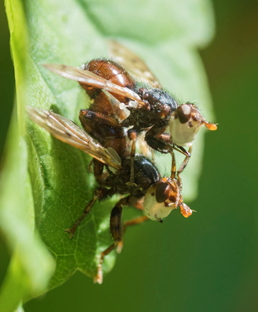
Pretty much a similar picture on Tuesday although the Large Red Damselfly puts in an appearance and one of the Crab Spiders seems to have gone into hiding. A few more Marmalade Hoverflies are about and along with some new bee species, at least these individuals look to be different to those already seen. A very small hoverfly is seen but not photographed, intriguing! A planted purple Allium by the back wall of the garden is almost in flower and the figs on the tree in the bottom corner of the garden are growing well although the leaves have not fully come out. There is a Holly Blue and a male Orange-tip is also seen there but apart from a Large White there are no other butterflies. Later and from my window three Blackbirds are seen foraging on the lawn along with a Magpie but few other birds show themselves.
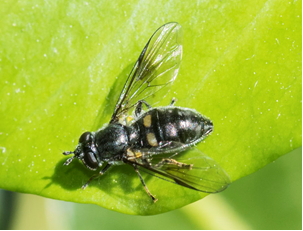
5th May – sunny but with a cold, sometimes strong wind which makes macro photography a bit more difficult. Around midday in the garden there are a lot of insects flying around including all the normal suspects such as Marmalade Hoverflies, Myathorpa florea, Syritta pipiens, Bluebottles and Greenbottles amongst others. The Myathorpa florea seem more abundant than previously and even cluster together in small groups in some sunlit spots although they spend a lot of time and effort chasing each other. What I think is a Soldierfly is present along with many different bee species and a pair of mating Conopid flies but the “Soldierfly” turns out to be a dumpy, rather black hoverfly with two spots of dull orange on the abdomen, a Pipiza sp (cf. P.noctiluca). Unfortunately dissection and a look at genitalia is the only way to speciate the members of this genus! The white faced, red eyed Conopid flies turn out to be Myopa testacea while the best of the bees is a Blood-Bee (unknown species of the genus Sphecodes).
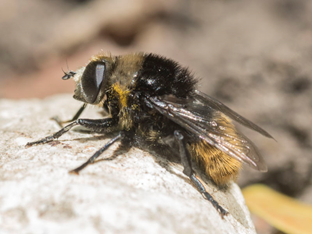
Five Large Red Damselflies are seen around the garden, mainly at the back but two are also found at the front along with the hoverfly called a Narcissus-Fly (Merodon equestris) found under the Horse-Chestnut tree at the front of the property. Butterflies include Holly Blue, Large White and Red Admiral with a possible female Orange Tip and the best bird seen is a Long-tailed Tit which flies in and then quickly disappears after initially landing in a tree right in front of me. The two crab-spiders on the Spurge do not show today but a couple of other spiders do which is good to see. One surprise is to find the Mirid bug, Closterotomus trivialis, a relatively new arrival to the UK. Actually a rather good insect day!
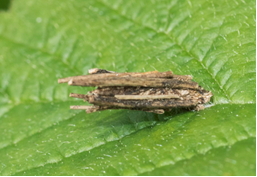
Not much to report from the following three days with similar insects seen and most flies seeming to disappear in the heat of the day although a couple of hoverfly species can be added to the list namely Platycherius albimanus photographed both in flight and perched, this is a small black species with grey spots and also the black and yellow Melanstoma scalare. Several flies are observed landing and then disappearing under the leaf on which they land which is one reason I struggle to find them. A single Blood-Bee is seen again but nothing Diptera wise that is different. Holly Blues and the Large Red Damselflies are still around but the two Misumena vatia spiders have gone from their normal haunt. A bit disappointing although the “nest” of a web spider with lots of tiny (2-3mm) spiderlings is found (but they had all gone by the next day!)
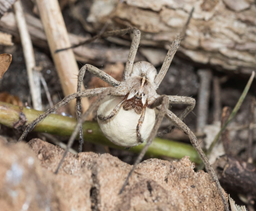
10th May – the Coombe Golf Course had opened its grounds to the public a few weeks ago and so a short walk up Kingston Hill takes me to St. Georges Rd and the golf course which is on both sides of the road but I only explore the side with the club house on it (holes 11 to 18). The edges of the site are wooded and there are trees with uncut vegetation between the fairways with some flowering plants, Queen Anne’s Lace, hawkweeds, buttercups and dandelions. It is not very sunny but there are several interesting bees (Andrena sp and Bumble Bees) and other insects around, a few hoverflies, a single Large Red Damselfly and another blue damselfly which quickly disappears. Holly Blues are also around along with a long horned beetle (Leptura species) and a rather black, dumpy beetle too. Larva and pupa of some lady birds (Harlequin only…) are on the surrounding fences and there is what looks like a piece of vegetation moving on a leaf. This proves to be a bagworm (a type of small moth in which the female remains in the larval case and does not fly – the males have to find her!). Wolf spiders with egg cases are seen along with a single Pisuara mirabilis also with an egg case is seen. Woodlice are found under some pieces of bark but nothing of great interest and it is a shame about the increasing cloud and strong wind which curtail my photography. This sites looks to have good potential.
11th May – Last possible day to visit the golf course as it reopens in two days due to the change in the lockdown regulations. Frustratingly another windy day and so it is hard to get shots but a few moths are seen (although not necessarily photographed). A rather white and hairy, dead moth is found, originally I think it has been infected with a fungus due to the hairiness but it turns out it is a Pale Tussock moth which is genuinely white and hairy. The sheltered spots look productive but nothing new and exciting appears despite a long, cold look! If only I had known the course was open before. A couple of Elm leaves are taken home to be photographed on the light box, one is smothered in Aceria campestricola galls (another gall mite) and the other has been eaten but in such a way as to leave the meandering trail of the eater (a caterpillar I would guess). Fascinating!
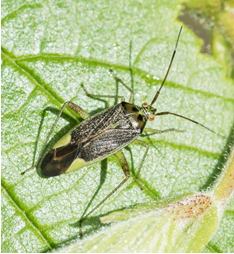
13th May – the first day of the reduced lockdown with unlimited exercise allowed and so I take a longer walk in Richmond Park, along the wall path to Ham Gate and then along the brook, up the side of the golf course before turning up the hill just passed Petersham Lodge. I am expecting there to be lots of people about but the Park is pretty empty (although four vehicles on the road in a five minute spell, a Police van, two Royal Park trucks and a car is a bit unexpected!). Maybe the weather which is a bit chilly with sunny spells plays a part in this but there are a few interesting invertebrates seen on the Bramble leaves. There is a small patch of Lesser Celandine in flower, Hawkweeds on the sandier soils and Bluebells are abundant throughout the wooded areas and in amongst the emerging Bracken. Speedwells are on the tops of some ant hills, a few Buttercups and some Hawthorn trees are also in flower whilst in the brook there is a Buttercup (Ranaculus species) flowering.
The Mirid bug, Closterotomus trivialis mentioned previously is the commonest bug although one or two others are also seen, a black and yellow one, Drysophilocoris flavoquadrimaculatus and the Striped Oak Bug (Rhabdomiris striatellus). Under a piece of wood there are Wood Lice, a beetle larva and several unidentified centipedes.
Spiders are also seen including one with a lovely green abdomen and brown thorax/head, a male Araniella as it turns out but for a while I think it might be Nigma walckenaeri, an imported species, but the best thing seen is a large Sawfly, one of those with the needle on the abdomen (probably a Rhyssa species) which unfortunately does not stop to rest on any vegetation. There is a Click-Beetle (under a log), some small red and black beetles that hide under leaves before disappearing and a green beetle with inflated thighs, Oedemera nobilis feeding on Dandelion flowers. Unfortunately the only ladybird present is the imported Harlequin, a few adults but mainly larva and pupa often on nettles. Birdwise the best things are a Song Thrush, seen and heard but otherwise just Jackdaws, Parakeets (including a single feather found on the ground) and Green Woodpeckers (heard but not seen). On the out of Kingston Gate a real surprise was to see a Royal Park truck leading a fire engine out of the Park!
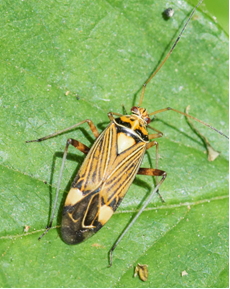
The following day is a bit warmer but the chilly wind still blows. After a good start with the spider Pisuara mirabilis seen low down on some nettles things slow down a bit but a few flies and other invertebrates appear and are photographed. There are at least three female Scorpion flies (Pandora species but no males) and several Crane-flies which are new for the year and there are the same bugs as the previous day plus an Andrena bee near Isabella Plantation, as well as a spotted bird that made a lot of churring noises. Not sure what it was and it disappeared pretty quickly. My first thought is Nightjar or even Wryneck but that is no doubt wishful thinking and it may have been a Thrush or even a young Blackbird, I really do not get a good look before it disappears. A real shame. Several Blue Tits are seen and usually with beaks full of caterpillars.
Moving on there is a small group, you can not really call them a herd, of about eight or so Fallow Deer on the edge of the road at the top of the hill up from Ham Gate known as Ham Cross with a lovely looking stag that closes its eyes as if to ignore me while it chews the cud and lies on the ground. Several of the females stand and walk away a short distance. Further on a herd of about 25 Red Deer females and youngsters are seen on the grassland between Isabella Plantation and Penn Ponds sheltering under some trees but I do not approach these as closely as the Fallow Deer which were within ten metres, if that of the road. Of course the problem with deer and getting anywhere near them or the paths they have been using through the Bracken is ticks. Later in the day I find three of these nasty creatures on me but luckily they had not dug in so were easily removed with no fuss.
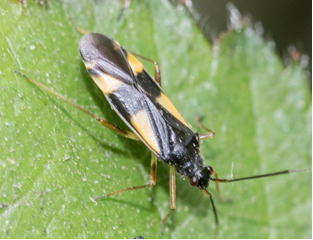
A warmer day follows and despite clouding up quite heavily in the early afternoon it is a day of some firsts, a Comma near Kingston Gate, a Small Heath appearing near Isabella Plantation and a Wasp Beetle in a sheltered spot of nettles near Ham Gate. However when it clouds over the insects appear to disappear but there is a small patch that has several “red” nomad bees and a single Blood-bee flying around close to the ground so there must have been some mining bee nests around that spot and even a couple of Bee-flies appear in different spots. Closterotomus trivialis, is once again the commonest bug although the black and yellow, Drysophilocoris flavoquadrimaculatus is found in several places and also running over the top of a small tree trunk. A single shield bug is seen on a bramble bush but there is no sign of the Striped Oak Bug today.
Along the side of the road leading up from Ham Gate a small drainage ditch on the left side has plants of Lady’s Smock (Cardamine pratensis) as well as many Common and other Rushes (the identification of which is not one of my strong points). The thick-thighed green Oedemera nobilis beetles are feeding on the Lady’s Smock. There are a few hoverflies around although most are the Marmalade Hoverfly and a single Large Red Damselfly puts in an appearance but today no Scorpion flies are seen. A bit of a weird day and not as productive as I am hoping given the previous two although once again several ticks are found on my full length trousers which have been tucked into my socks, after yesterday I have decided to give the shorts a miss just in case… But it made no difference it seems to the ticks because they find my legs just the same.
Saturday 16th May is a busier day in the Park and so I head away from Ladderstile Gate towards Robin Hood Gate but then cross the car-park where the Isabella Plantation Café is located (and open) before going across the road and then heading down the hill onto a wooded path that has gates and is fenced (but had no name) which separates King Charles Spinney and Dodd Pond woodland. It is in reality a narrow woodland ride with many Bluebells still in flower but mainly going over along with a few plants of Garlic Mustard, Brambles and various trees and bushes. As I go through the gate a Song Thrush is feeding on the ground but it soon disappears and further on a Blackcap sings loudly whilst a Chiff-Chaff calls from the tree tops. A Wren and Robin also make appearances and above the horrid whine of a drone can be heard. I do not see it so maybe it is a Police one but if not it shouldn’t be here…
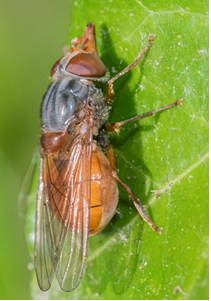
The insects are interesting although there are only a few hoverflies including a Xylota segnis, Rhinga rostrata and unusually just a single Marmalade Hoverfly. Perhaps the most noticeable insects are Click-beetles (all Athous haemorrhoidalis), there must be at least a dozen seen (usually I count myself lucky if I come across just the one!).
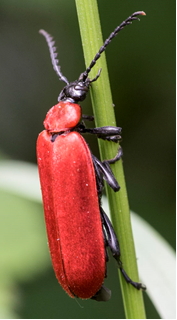
The insect that literally stands out is a bright red (including head) Cardinal Beetle (Pyorrhoea serraticornis) walking across the top of a leaf. There are only a few butterflies, a single male Brimstone floats by outside the ride and a couple of Speckled Woods fight over a sunlight spot. Nothing too exciting but a promising area and well worth investigating on a sunny rather than a cloudy day with a few, rather short sunny spells!
The following day starts cloudy but by noon the sun has broken through so I revisit the same spot as yesterday hoping it will be as productive as I hope. It is not brilliant but still yields more insects including a Curculio weevil and some Craneflies (Tipula sp and the smaller and orangey Limonia phragmitidis). A single Soldier Beetle is seen and this turns out to be Canthras lateralis, which has wing cases that are black(ish) and with red femurs that blackened towards the bend. Another Cardinal Beetle looking slightly more powdery and less densely coloured than yesterdays is found and this one has a black rather than a red head so is another species, Pyorrhoea coccinea. The same species of Click-beetle is still abundant and there are a few flies, the predatory Empis species, Xylota (probably X.segnis) and other species I do not worry too much about. So after this I go home and look forward to the following day.
It is not an early start but an Anthophora bee is spotted on entering Ladderstile Gate and only a few other bees are noted but not photographed although a Sawfly, a Tenthendro species (one of those with a yellow and black abdomen) is but it proves impossible for me to identify to species level. Several blue damselflies appear on some Bramble bushes but remain too far away to photograph and they are no doubt one of the commoner ones, Azure and/or Blue. Only one spider is seen but it disappears very quickly under a leaf. However on the way to the Park I spot another web-spider “nest” on some Ivy which is photographed (Araneus species). Not a bad few hours spent trying to avoid the crowds in the Park which are still growing as I leave at about 15:30!
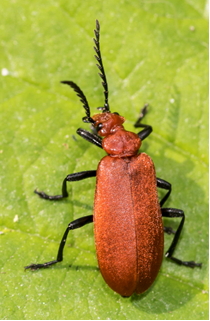
Monday is a warm day from the start and there is also a warm wind which hinders the photography a little bit. There is not much new to photograph in the same wooded ride as the previous two days. The Cardinal Beetle (Pyorrhoea serraticornis) re-appears and there are the normal flies along with two male Brimstones (one nectoring on a Bluebell) and several bees that also are taking pollen from the Bluebells and a really fresh Orange-tip butterfly which does not hang around for very long.
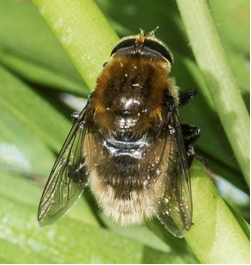
The Click-beetles are still abundant and a Blackcap is flittering around too. Scorpion flies appear but do not want to have their photos taken and the Xylota hoverflies play hard ball refusing to be photographed along with another buzzing hoverfly the noise of which is gives away its presence. It appears to be Eristalis intricaria, a white tailed bumble-bee mimic (the photographs confirm the identification). A couple of spiders are seen, one is a jumping spider and the other is on a web, one of the money spider family (Linyphiidae). Not a badly spent two hours and on the spur of the moment too!
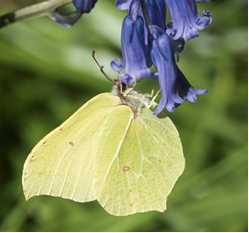
Tuesday is Penn Ponds day. A look online the previous evening has implied there might well be Common Terns nesting on rafts in the ponds so I think it would well be worth a look and therefore head in that general direction via Kingston Gate after first getting a coffee from Nev and Chrissie on Norbiton Station who had re-opened on Monday. It is a bit of a detour but well worth it for the coffee! This is to be more of a birding day so I take the long lens with me as well as the macro (which remains unused for the first day in many weeks!). Amongst some Oak trees a couple of Blackbirds are feeding (an adult and juvenile) and a Nuthatch is seen going up and down a couple of trees before disappearing. Two Grey Squirrels then appear in the same spot. Moving on there is a small herd of female Red Deer and a male with velvet covered horns (they were small and straight rather than full blown antlers). One stands on the edge of the trees whilst the others stand back under the shade, this is to be the warmest day of the year so far (sunny and up to 27 or 28C). Moving further up the hill and onto the flat area in front of Isabella Plantation only gives me Jackdaws foraging amongst the ant-hills and grass.
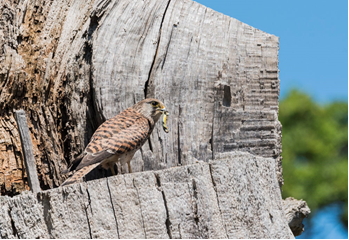
After that I cross the road that leads towards Penn Ponds and head towards them across the grassy plain in the middle of the Park called Slade Pond. A Skylark sings but then goes quiet and a Kestrel is seen hovering. It is soon mobbed by Jackdaws and a crow. Disappointed I head closer to Penn Ponds and speak to a guy who has also been attempting to photograph the Kestrel that is being mobbed. He points out the bare, dead tree a hundred metres further on and says that is where the Kestrels are nesting. He is right and apparently it is a well known spot for the local birders and photographers. I spend sometime there photographing mainly the female, and two passing Buzzards while watching people pass by some who are totally obvious to the Kestrel perching in a tree right in front of them (but who are very happy when it is pointed out to them). A couple of male to female food passes are witnessed but the only one I photograph is when the prey item is a lizard, a Common and not Sand Lizard I hope… Roger from the Richmond and Twickenham RSPB group stops for a chat with a friend and he points out the Sand Martins flying around before showing me their nesting site. It is on Penn Ponds but too far away to photograph. A small group of the Sand Martins fly near me and even land on the footpath before walkers disturb them but I do get a couple of shots before that happens. When it is clear the Hobby I have been told is around is not going to show and that the Sand Martins have moved on it is time to go back to the Kestrels.
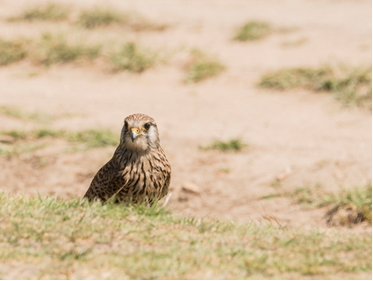
The female Kestrel flies straight at me before veering off and then she lands on the sandy footpath. She just walks around ignoring people and even letting some get within a metre or two (no social distancing for her). I take some photographs but she disappears into a dip and only flies off when someone else gets too close (and they had not even noticed she was there). After that it is time to go and eat so I head back to Ladderstile Gate stopping a few times on route but only photographing a warbler high in a tree – it is a Phylloscopus species rather than a Whitethroat (which I was told are now common in the Park) because it has a pale stripe over it’s eye. Two Kestrels suddenly appear and disappear before I get to the Gate. These are not the same pair who nest in the dead tree but are another pair with a different territory. Despite the fact there have been no Common Terns on the Ponds it has proven to be a wonderful bird day and the first real birding day in nearly two months!
It seems prudent to revisit the Kestrels and Penn Ponds so that is what I do the following day, another hot one so I go out earlier than the day before. The Kestrels are hunting over the grassy area but there are a group of people already hanging around the nest tree so I decide to go past and check out the Sand Martins again. A small patch of scrub behind a fence produces, as some-one had said it would yesterday, a lovely male Reed Bunting and a Whitethroat. There is even a single Common Tern so not all of them have passed through. A lone Grey Heron is seen as are lots of Sand Martins, Mallards, Greylag Geese, Tufted Duck and Egyptian Geese to name the commoner birds and of course Jackdaws which are everywhere and usually one or two continue to mob the Kestrels when they are trying to hunt. After walking around the Penn Ponds and back to the Kestrel nest tree it is good to find most of the early photographers (there were about nine of them!) have disappeared so I wait and get a few more photos. The only prey item taken into the nest is another Common Lizard. Not as many photos as yesterday are taken but I possibly have some decent hover shots for a change, and head on to, usually I only manage to get sideways on shots, are taken! I am back home by 13:30 – it feels too hot to be out any longer…
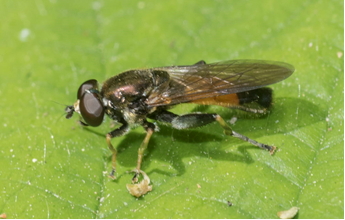
The photographs of the in flight Kestrels could have been better exposed so after a trip to Kingston town centre I go back to them the following day. It is still pretty hot and the Kestrels do not really perform as well as the previous day but I get a few more shots of the female, including with some with a beetle grub she finds and takes into the nest. The male is noticeable by his absence. Other birds include the Sand Martins, Jackdaws, Song Thrushes, Parakeets plus the normal water birds on Penn Ponds (including two Grey Herons today) although no Common Tern, Reed Bunting or Whitethroat but a Jay is seen being mobbed around a Willow tree. Maybe it is after the young of the Tits which I think the mobbing birds are. And then out of the blue a beautifully lit Red Kite slowly soars passed before climbing and disappearing into the sky. Its forked tail almost glows red-orange, a lovely sight. The only insects I pay any heed to are a mating pair of Large Red Damselflies, some blue Damselflies and a Chaser dragonfly (Libellula depressa).
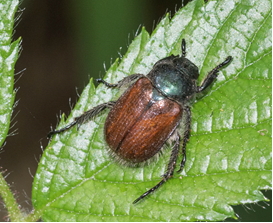
23rd May – starting warm but cooler than the previous few days and with clouds and a little rain in the form of short showers. My first stop is the wooded path by the side of King Charles Spinney. The Brambles are just coming into flower but the Bluebells are almost over. There are not many insects to see at first and they all seem to disappear when the clouds came over. Xylota segnis and Marmalade hoverflies are seen along with a largish black one (which is an unidentified Cheilosia species). There is also a female Helophilus hybridus with hind femur that is clearly two-thirds black separating it from H.pendulus. Only a couple of Scorpion flies are found but there are several species of bee, Bumble and others including two Nomada species. A couple of very small green Bush Crickets are seen on the bramble leaves but Click-beetles appear to be absent until I come across a spot where there are about half a dozen and they then seem to show up elsewhere in the ride too! Other beetles include several Soldier Beetles (Canthras lateralis), a small red and black spotted Harlequin Ladybird and there is a lovely looking Garden Chafer (Phyllopertha horticola) in the same spot as the distinctive long-horned moth Nemophora degeerella.
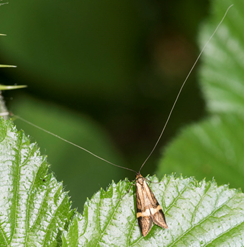
The only other moth I come across is not an imago but a green caterpillar that is crawling up a Silver Birch tree! Butterflies are not very evident with only a Large White and Speckled Wood although there are several Small Heaths in the grassy areas of the Park. A quick visit to the Kestrel nest site does not really go to plan because the first of the squally rain showers comes just after I get there and it is time to head home before the real showers start.
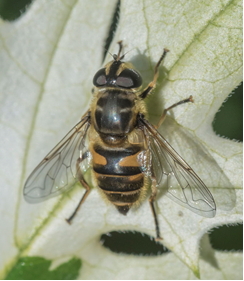
The following day it is another cloudy start but a warm day without the light showers although there is a bit of wind still blowing strongly. My main focus is on the Kestrels again with the aim to get some good in-flight shots but the birds are not so keen to play. Nevertheless I manage to get some shots of the male with a bird chick as the prey item, apparently not uncommon so others tell me, he has caught and delivered a Robin to the female in the past I have been told. The female stays around the nest occasionally diving down from her perch and attacking a Jackdaw or two but nothing more serious than an attempt to scare them off or just to bully them. Moving on Penn Ponds prove interesting with at least two dozen Swifts accompanying the Sand Martins and zooming around low over the water as well as going high into the sky. A single Great Crested Grebe is also seen along with two Grey Herons, one on each side of the Ponds but not a lot else, other than two Jays in the woods around the Ponds and a pair of Buzzards flying overhead.
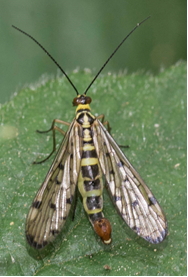
The Bank Holiday Monday is warm, mainly cloud free and with hardly any wind at all, a much hotter day than the last two. In the garden both the Elder and Red Valerian are in full flower but neither attracted any insects unlike the white flowered bush (?Smilax) at the front of the building which has many Honey Bees, a few hoverflies including Myathora florea, Syritta pipiens, Eristalis tenax and a couple of others as well as some solitary bees. The Anthophora plumipes colony has gone very quiet so I guess that is it for this year and that the eggs and larva are safely sealed inside their underground nests and the adults have died off. There are a few orb-web spiders sitting on webs while the Araniella cucurbitina in the garden is looking about twice the size it has previously been and she is still on her web in the same place as before, on the upper surface of a Horse-Chestnut tree leaf. A male jumping spider, Salticus sp, is seen running up and down a tree trunk but perhaps the best sighting of the day is of the un-photographed metallic green Rose Chafer (Cetonia aurata) – it is too high for me to get too! Overall the total number of insects, as well as species, in the garden seems a lot lower than the previous weeks. Birdwise a pair of Magpies are seen along with adult and juvenile Blackbirds foraging at the back of garden but these fly off when I appear.
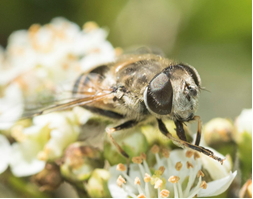
Another visit the following day to the King Charles Spinney path and the clouds come over so it is warm but sun free for a lot of the time. Insects appear to be sparse although Speckled Wood, Red Admiral and male Brimstones are seen. A Xanthogramma hoverfly is seen by the entrance along with a Narcissus-Fly, a hoverfly with a very distinct buzzing sound, and along with a new species from the genus Sphaerophoria. It is not possible to speciate the females of this genus and to identify the males a good look at the genitalia is required so they will remain at genus level only except for S.scripta where the abdomen is longer than the folded wings! A Marmalade Hoverfly is egg-laying near some aphids that are being tended by some black ants on a budding Bramble and a few other flies are also seen, a male Scorpion fly looking smaller than the females but the most interesting is a bright red and green Ruby-tailed Wasp, my first of the year. The Click-beetles are still numerous and a Striped Oak Bug is found along with a couple of Harlequin ladybirds but nothing else. There is a smattering of rather small (c.5-6mm) green and very black dotted Bush Crickets on the top of some leaves. A disappointing visit given the warmth of the day and the number of illegal cyclists, individuals and groups of three in the Park also adds to my disappointment.
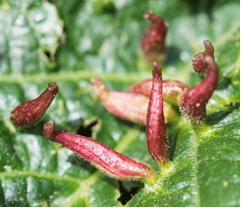
A lovely clear blue sky starts the day but it clouds up by about midday and then the sun shines again later in the afternoon. The garden isn’t very productive but a Speckled Wood is seen along with a few bees and flies. Where the Garlic Mustard was flowering a small group of Geraniums are now in flower, they have dark purple flowers. Some of the roses in the front of the garden smell very strongly and it is a pleasant smell. There are even a couple of Hoverflies taking nectar from them, a Marmalade Hoverfly and a Eupeodes luniger. The Myathopa florea are still flying and chasing any other fly, or flies that gets to close, and a new species is Eristalis arbustorum. It takes some time but having learnt the lesson from previously unidentified Eristalis species I make sure I get a photo of the face which is required for a positive identification. Two types of red gall are spotted on a small, young Lime tree in the front garden. Both are caused by gall mites with the one on the stem being caused by Contarinia tiliarum and the nail galls covering several leaves are caused by mites of the genus Eriophyes (species undetermined).
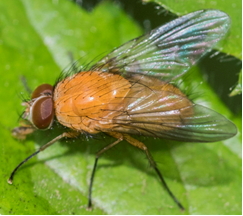
In the afternoon Richmond Park beckons and walking from Kingston to Ham Gate does not prove very productive with only a lovely orange bodied fly which I think is from the family Muscidae, Phaonia pallida and one large log with lots of small holes had a host of small Hymenoptera (<5mm in length and very narrow) zooming around and entering the holes at times. Exactly what they are remains unknown and even looking at the photos is unlikely to help. A single Soldier Beetle (Canthras lateralis) is seen running down a fence post but no other beetles are noted.
Plants include Mouse-ear, Ladies Smock, Ladies Bedstraw, Hawkweeds, and lots of Foxgloves of varying shades of purple and with some white ones too but most of the Bluebells have well and truly finished.
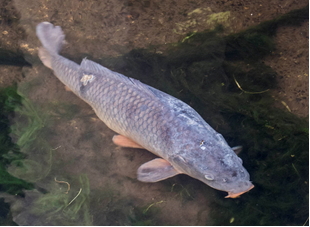
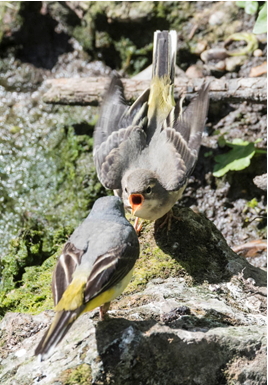
28th May. Yet another warm day after a slightly chilly start and one to explore a little so I am heading into Kingston to see if there are Kingfishers around Clatten Bridge as I had been told. No Kingfishers appear unfortunately but the squawking of a bird attracts my attention. There on the small piece of actual river bank is a Grey Wagtail chick calling out to be fed. The parent bird is flying around, hovering along the side of the bridge picking insects from out of the air and delivering them to its chick. Another adult bird and chick also appear but this youngster appears to be more active than its sibling because it is flying around and following the adult bird. This is a good start to the day. A Pied Wagtail has to get on in the act calling out loudly before appearing right in front of me, my first Wagtail for some time and then a Grey Heron flies over head following the stream to the nearby River Thames while under the water a school of large Chubb swim against the current waiting for whatever the stream brings to them although slightly upstream one of their number is seen dead on a small gravel bank with a Crow pecking at the corpse.
Heading towards the River Thames a small family of Canada Geese are swimming around, two adult birds, one of which is chased and attacked by a cob Mute Swan but it survives the attack and the other Goose with the three, yellow chicks swims away from the two squabbling birds. On the river itself lots of Mute Swans appears, as they normally do, and one chases and attacks many of the others while a single floating Great Crested Grebe sleeps and goes drifting by. Apart from a few Coots, pigeons, Black-Headed and Herring Gulls the variety of birds is not far from what is expected.
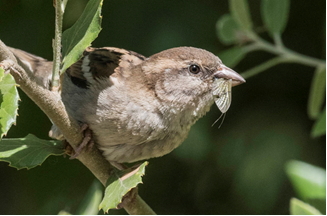
Walking under Kingston Bridge towards Ham and via Canbury Gardens a few more birds are seen; a single Cormorant perching on a boat, another Grey Heron preening on a dock followed by a Pied Wagtail also on the riverside. Further along no new birds other than House Sparrows and Starlings appear which is a shame although the agility of the sparrows as they pluck Mayflies from above the water is amazing to witness. However the flowers on the riverside are out, mainly water-dropworts, an umbel, with many insects, mainly Honey Bees nectoring on them. A single unidentified Dragonfly flies by but nothing else of note is seen. Maybe tomorrow a more thorough insect hunt needs to take place!
Today is warm once more so I head back to the River Thames with the macro lens as well as the long one this time. Kingston Bridge yields the same birds as yesterday although a pair of Grey Wagtails are also showing and flying under the bridge where a couple of Swallows are also seen. By Turk’s Boat House the Grey Heron is seen on the same jetty as the yesterday only this time it goes into the water and disappears for a few minutes under the wooden pier. A Pied Wagtail is seen on the water’s edge and two more are heard and seen further along the towpath. Three Red-crested Pochard are spotted flying and then swimming in the river. These are likely to be escapees as they are not a UK breeding bird.
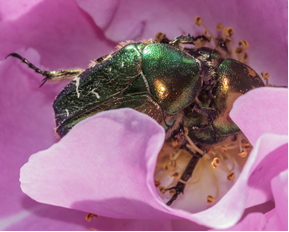
Canbury Gardens is busy with people, families and people on bikes and the only real highlight is the small collection of various roses on the edge of the Gardens at the Teddington end. A soldierfly, a green Chloromyia species sits still on a rose leaf but better still are the five or maybe even six metallic green Rose Chafers that are feeding on the rose flowers, mainly the pink and lovely smelling ones. A few other insects are around but do not settle. Further on an amazing sight is a Pied Wagtail taking insects from the surface of the river, its agility is far greater than that of the Sparrows and it seems to be dancing around at incredible speed to catch its prey.
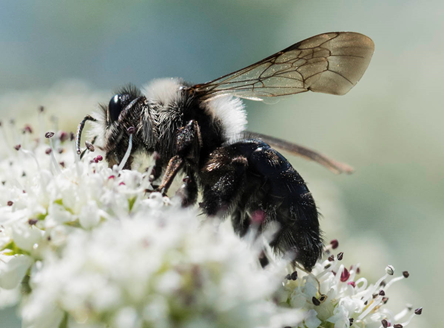
Along the towpath the dropworts and other flowers are attracting insects, mainly bees and Honey Bees at that. There are a few Bumble Bees and small solitary bees but not many. Hoverflies are also sparse, a few Marmalade and Footballers (Helophilus species) but that is about it. Damselflies are also few in number but there are a few Common Blue Damselflies (Enallagma cyathigerum) and two of the larger dark winged male Banded Agrion (Agrion splendens). A Myrid bug (related to the Potato Capsid if it is not that species although certainly of the genera Calocoris) is found on a yellow flowering crucifer but that is about it apart from a beautiful black and white bee which is seen several times along the towpath and is identified from the photos as the Ashy Mining Bee (Andrena cineraria). Heading away from the river at Ham there are a few patches of Ox-eyed Daisies and some have insects on them, mainly the green, large thighed beetle Oedemera nobilis but one has a solitary wasp on it and another a Ruby-tailed Wasp (Chrysis sp). However the wind blows making it difficult to get decent photos. A pleasant four and a half hour walk but not the quantity of insects I am hoping for but possibly the bee photos will produce quality instead!
 Leave a comment about this comment
Leave a comment about this comment